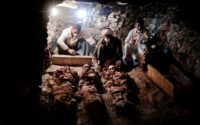 The Draa Abul Nagaa necropolis in Luxor has had an extraordinarily productive year. In April Egypt’s Antiquities Ministry announced the discovery of a more than a thousand ushabti funerary figurines, eight mummies and 10 wooden sarcophagi with their polychrome paint still vivid in the tomb of an 18th Dynasty judge named Userhat. A month later the Spanish National Research Council revealed one of my favorite Egyptian finds of all time: the first funerary garden ever discovered. To that outstanding record we can now add the tomb of a New Kingdom goldsmith.
The Draa Abul Nagaa necropolis in Luxor has had an extraordinarily productive year. In April Egypt’s Antiquities Ministry announced the discovery of a more than a thousand ushabti funerary figurines, eight mummies and 10 wooden sarcophagi with their polychrome paint still vivid in the tomb of an 18th Dynasty judge named Userhat. A month later the Spanish National Research Council revealed one of my favorite Egyptian finds of all time: the first funerary garden ever discovered. To that outstanding record we can now add the tomb of a New Kingdom goldsmith.
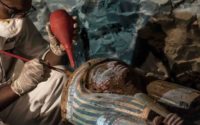 Archaeologists excavating the site unearthed a tomb replete with figurines, mummies, painted sarcophagi, jewelry, combs and, even more important to researchers, a statue whose inscription identifies the owner of the tomb as “Amun’s Goldsmith, Amenemhat.” The statue is a portrait of the Amenemhat seated next to his wife, a painted portrait of their son between them. His wife, identified as “the lady of the house,” was named Amenhotep, an unusual choice as it was traditionally a male name. The statue was placed in a niche in the courtyard of the site. According to the Egyptian Minister of Antiquities Khaled Al-Anani, the tomb dates to the 15th century B.C. during the 18th Dynasty of the New Kingdom.
Archaeologists excavating the site unearthed a tomb replete with figurines, mummies, painted sarcophagi, jewelry, combs and, even more important to researchers, a statue whose inscription identifies the owner of the tomb as “Amun’s Goldsmith, Amenemhat.” The statue is a portrait of the Amenemhat seated next to his wife, a painted portrait of their son between them. His wife, identified as “the lady of the house,” was named Amenhotep, an unusual choice as it was traditionally a male name. The statue was placed in a niche in the courtyard of the site. According to the Egyptian Minister of Antiquities Khaled Al-Anani, the tomb dates to the 15th century B.C. during the 18th Dynasty of the New Kingdom.
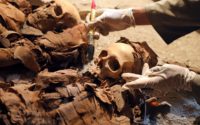 The team unearthed two burial shafts. The first one archaeologists excavated and explored connected to a funerary chamber with multiple mummies, about 150 wood, clay and limestone ushabtis and funerary masks. The chamber at the end of the second shaft held the mummified remains of a woman and two children. Osteological analysis of the woman’s remains indicate she was about 50 years old when she died. She suffered from a painful bacterial bone disease, although it’s not clear if that was the underlying condition that led to her death. The two adult males with her, likely her sons, were in their 20s and 30s at time of death.
The team unearthed two burial shafts. The first one archaeologists excavated and explored connected to a funerary chamber with multiple mummies, about 150 wood, clay and limestone ushabtis and funerary masks. The chamber at the end of the second shaft held the mummified remains of a woman and two children. Osteological analysis of the woman’s remains indicate she was about 50 years old when she died. She suffered from a painful bacterial bone disease, although it’s not clear if that was the underlying condition that led to her death. The two adult males with her, likely her sons, were in their 20s and 30s at time of death.
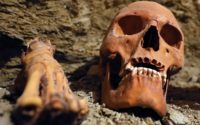 There is no evidence linking the remains to Amenemhat, so we don’t know if this is the wife depicted in the statue or someone completely different. Many tombs at Draa Abul Nagaa were reused for centuries, and this one was no exception. It was reused for burials during the 11th and 10th centuries B.C. (the Third Intermediate Period).
There is no evidence linking the remains to Amenemhat, so we don’t know if this is the wife depicted in the statue or someone completely different. Many tombs at Draa Abul Nagaa were reused for centuries, and this one was no exception. It was reused for burials during the 11th and 10th centuries B.C. (the Third Intermediate Period).
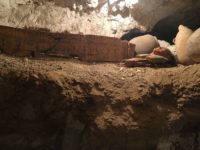 The excavation is ongoing and Al-Anani is hopeful that the team will be able to unearth more tombs, remains and artifacts. Dig leader Mostafa Waziri, head of the Antiquities Ministry’s Luxor department, thinks there are four more tombs adjacent to the goldsmith’s tomb. It was Waziri and his team that discovered the plethora of ushabtis and mummies in the judge’s tomb earlier this year, so it’s been a banner year for them.
The excavation is ongoing and Al-Anani is hopeful that the team will be able to unearth more tombs, remains and artifacts. Dig leader Mostafa Waziri, head of the Antiquities Ministry’s Luxor department, thinks there are four more tombs adjacent to the goldsmith’s tomb. It was Waziri and his team that discovered the plethora of ushabtis and mummies in the judge’s tomb earlier this year, so it’s been a banner year for them.
Al Uxor = “The Lady of the House” (here, likewise with a male pronoun) :p
The necropolis, or ‘city of the dead’, of Dra Abu el-Naga seems to be only a fraction of the massive ‘Theban Necrotope’. Did I miss the picture of Amenemhat, seated next to his ‘Lady of the House’ ?
Were Amenemhat and his ‘Lady’ the original owners of this 18th Dynasty tomb, i.e. till 500 years later, New Folk –seemingly, ‘reusing’ the lower parts of the poor Lady’s coffin– was moving in ?
People frequently suggest using ancient DNA to restore the mammoth to life. But I never see anyone wanting to recreate people from the past. The obvious one to try is classical Greece. Clever buggers those Hellenes. Why don’t we restore a few and see what they can achieve? Or, perhaps easier, some Victorian Britons – another gifted mob. Who else?
And why focus on intelligence? Was there any people famous for their pulchritude? Any other virtues (if virtues these be) that would be worth a punt?
This foot was made for walking
And that’s just what it did
And one day, as time walks by, we gonna dry with it
:boogie: